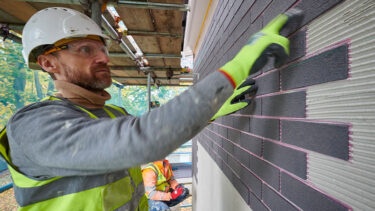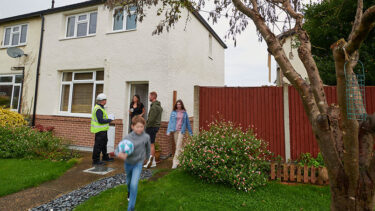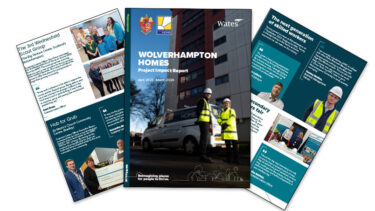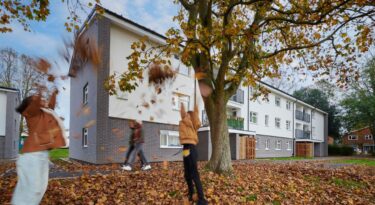Winning business strategies in many sectors today look quite different from the ones common in earlier years, when the accepted view was to compete and prevail, with ‘self’ as the central theme.
New complexities, a greater diversity of challenges and a more sophisticated understanding of the value of corporate social responsibility is changing all that. There are many other influences, of course, as well as notable collaboration successes, so working together to achieve a common goal is common sense and here for the long term.

“Our experience at Wates has shown the real-life virtue of collaboration in project delivery,”
says Ben Williams, Head of Head of Zero Carbon Retrofit at Wates Property Services. “The proof of it is in our decarbonisation retrofitting work in the social housing sector. Building owners have hard-edged carbon reduction targets and deadlines demanded of them by government for their housing stocks. It’s hard to achieve and expensive.”

Under the previous government’s Social Housing Decarbonisation Fund (SHDF), just over £2bn was made available for the period 2023 to 2028 for decarbonising social housing stock in England. During their first budget in October 2024, the Labour government launched its replacement for the SHDF, the Warm Homes: Social Housing Fund (SHF). This means that funding will continue to help social housing landlords meet their targets decarbonisation targets and deadlines. The funding whilst available, must still be bid for, won and also matched to at least 50% by each submitting social landlord. There is also jeopardy embedded in the funded element if, for example, the retrofitting doesn’t reach standard. Added to this are wider budgetary issues for providers, the requirement for certified and competent contractors, along with multiple other delivery issues

The scene is complex, but as Wates and a consortium of Hertfordshire based housing associations have found, collaboration can show the way forward.
The consortium combined forces in 2022 in a collaboration with the stated aim of achieving a ‘net zero carbon footprint by 2050’ (in line with the UK target). The partnership was widened in late 2022, when it was joined by a further social landlord to better position themselves for securing funding from the SHDF.
Partnering for efficient and effective delivery
“Retrofit challenges aren’t unique, and by comparison to the large-scale construction projects we deliver, don’t have the same implications, but this only serves to underscore the importance of the collaborative approach more widely,” Ben Williams points out. “They may not be unique, but they are big enough to encourage people to get round the table, unpack the intricacies and take joint responsibility for them.”
One of those intricacies, often lost among the financial, technical and operational matters that dominate people’s attention, is the invasion of privacy that retrofitting brings for residents. Access to people’s homes, their place of security and safety, is required, and inevitably leads to disruption. So, speed and efficiency coupled with the ability to cater for all elements of what is essentially a people-centred operation rather than a building project is imperative. A collaboration, with everyone working to the same agenda, is a proven delivery methodology. More widely, the partnership approach provides much greater long-term security and certainty for customers, helping to indemnify them against some potential future failure
In the case of our work with the Hertfordshire consortium, £14 million has been successfully secured so far. On top of this, a further £25 million has been pledged by the partner to improve homes across the county.
Investing in collaboration
For Wates, that initial no-obligation contribution, is treated as an investment rather than a cost to the business. “We’re perfectly straightforward with people about it,” says Ben Williams. “We’ll bring our knowledge and experience to help you achieve your goals. If we’re effective and you enjoy working with us, let’s continue the collaboration: we’ll help you deliver on the ground as your contractor.” It’s the retrofit industry equivalent of ‘try before you buy’. Attitudinally, it’s the right lens to view the matter through as well, not least because it focuses the mind on the success criteria.
Support with the funding application is a key element of the collaboration for Wates but it extends beyond this to ensure that, overall, the retrofit project is delivered as efficiently and effectively as possible. For the client it not only helps mitigate the funding risks referred to earlier, but it also ensures that efficiencies ripple out across the project as a whole to the advantage of other features such as the resident/tenant experience, supply chain engagement, and the effects on the wider local economy. Beyond this, where projects increase in complexity, the attraction of collaboration rises correspondingly. On a recent project in Hertfordshire, where retrofits needed to be carried out on heritage homes in multiple locations, delivery was dependent on different agencies; in this case a local heritage foundation and planning, as well as engagement with local resident groups.
Locking into local expertise
“Our aim on these projects is to deliver using local businesses and social enterprises wherever possible.” Ben Williams comments. “By local we mean within a 30-mile radius of the project. We start by organising ‘Meet the buyer’ events. We invite people to join us and talk to them about the opportunities ahead. For us, it’s testing the market. It creates understanding and often surfaces gaps – skills or certification, for example. But these are matters we can deal with there and then. We work with other partners such as Trustmark and Simply Certification, who are there alongside us to guide people through qualification. They can start working with people immediately, providing the advice they need to achieve the right certificates – PAS2030/2035 and Microgeneration Certification Scheme are notable examples. If we can bring local people into the supply side, both social enterprises and others, we introduce new (SHDF/SHF) money into the local economy that circulates there rather than coming in and leaving, with very little ‘stickiness’. If those people were not sufficiently experienced or qualified before, we’ve left them with something new in their skill set that they can apply elsewhere. Exactly the same applies to the partners’ apprentices we take on.”
The size of the prize
Across many borough councils, the social housing stock is ageing – much of it produced in the aftermath of the Second World War using system-built designs, such as Cornish and Orlit. characterised by the use of concrete reinforced panels, blocks and structural elements, they are highly inefficient. Combined with other poor-performing buildings, many councils have established that housing accounts for somewhere just over 40% of their carbon emissions. This is a sizeable and worthwhile proportion of emissions to tackle, and there is much to be gained by making homes more efficient.
The agility, speed and effectiveness a creative and high-performing collaboration can bring is shown through examples like the Hertfordshire consortium to help turn the decarbonisation tanker around.






